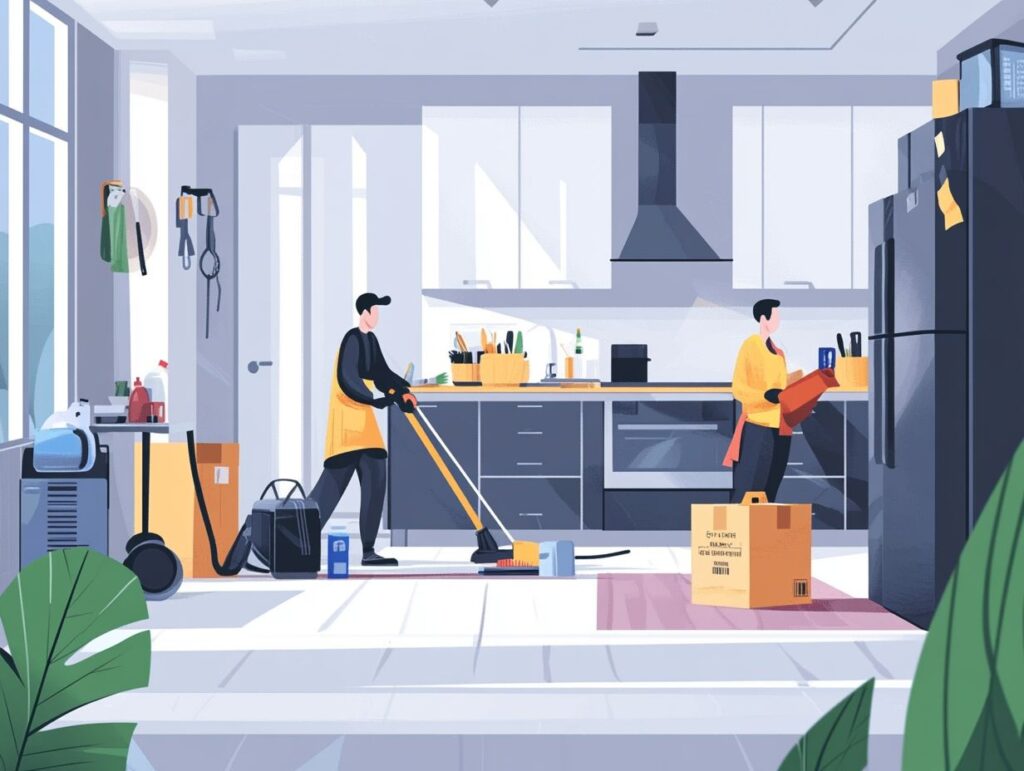The complexities of end of tenancy cleaning can be quite daunting, especially for first-time tenants. Understanding the concept of “reasonable wear and tear” is essential to avoid disputes and ensure a smooth transition at the end of a lease.
This article explains reasonable wear and tear, offers examples to differentiate between normal and damaging wear, and outlines landlords’ expectations. We will also share tips for effective communication and documentation to keep everyone on the same page.

Understanding Reasonable Wear and Tear
Understanding reasonable wear and tear is key for both tenants and landlords. It sets the stage for what is acceptable regarding a property’s condition during a tenancy.
Fair wear and tear is all about the normal wear that happens when someone lives in a rental—think of the usual scuffs on walls, the slight fading of furnishings, and the wear on flooring and appliances. This concept significantly determines tenant obligations, landlord responsibilities, and how the property’s condition is assessed when a tenancy concludes.
Understanding this can help you avoid disputes over security deposits and cleaning fees once a tenant vacates.
Defining the Term
Reasonable wear and tear is about the natural wear a rental property experiences over time due to everyday use and occupation.
It’s important to differentiate this from excessive damage, which usually comes from neglect or abuse—something tenants and landlords need to remember. The overall condition of rental properties often hinges on how cleaning standards are laid out and what rights tenants have when maintaining their spaces.
For example, faded paint or scuff marks on the walls? Reasonable wear. But those large holes or significant stains? Not so much. Grasping these little details helps clarify what landlords expect, ensuring properties stay in good condition without putting too much pressure on you as a tenant trying to understand your rights and responsibilities.
Examples of Reasonable Wear and Tear
Examples of reasonable wear and tear can vary, but they mostly include things arising from using your home normally. Consider minor scuffs on the walls or slightly worn carpets.
Normal vs Damaging Wear and Tear
Normal wear is just the usual wear and tear you’d expect in a rental property while damaging wear can spark disputes over your security deposit and cleaning fees.
Normal wear includes minor scuffs on the walls, slight carpet stains, and the natural fading of paint. These are the little quirks that come with everyday living and don’t really hurt the property’s overall value. On the flip side, damaging wear involves serious issues—like large holes in the walls, deep carpet tears, or extensive water damage—that can hit your wallet hard with expensive repairs.
Using cleaning and inventory checklists helps with property evaluations to make your move-out inspection as smooth as possible. These lists ensure you systematically tackle all the cleaning tasks while giving you a detailed rundown of the property’s condition. This way, it’s easier to determine if any damages go beyond normal wear and could lead to deductions from your security deposit.
End of Tenancy Cleaning Requirements
Cleaning requirements for the end of tenancy can affect whether you’re a tenant or a landlord. They establish the cleaning standards you must meet before that all-important move-out inspection.
What Landlords Expect
As a landlord, you usually expect the property to be returned in a condition that matches the cleaning standards in the tenancy agreement.
This expectation often extends to shared spaces like corridors and communal areas, which should be spotless and clutter-free. Appliances—think fridge, oven, and dishwasher—need a thorough scrub to get rid of any grease or food residue.
Ideally, you’d want the carpets hoovered, and if they’re looking a little worse for wear, a professional clean will ensure they’re stain-free. Don’t forget the walls; a quick wipe down will help eliminate scuff marks or dirt.
During the move-out inspection, you’ll be examining these areas closely. Any shortcomings might lead to justified cleaning fees or deductions from the tenant’s security deposit, so meeting these standards is extremely important.
How to Determine Responsibility for Cleaning
Determining who is responsible for cleaning at the end of a tenancy can sometimes lead to disputes between tenants and landlords. Therefore, it is essential to understand the guidelines set out in the tenancy agreement.
Factors to Consider
When determining cleaning responsibilities, several factors should be considered, such as the condition of the property when you moved in and any normal wear and tear that has occurred during your stay.
Conducting a thorough assessment of how long you’ve been there is key, as longer tenancies often mean more signs of use. The condition of the furnishings and appliances is essential, too; a well-maintained flat with newer fixtures might require less cleaning than one that has seen better days.
An inventory checklist can be a game-changer for you and the landlord. It helps establish clear expectations about the property’s condition, directly affecting how cleaning responsibilities are allocated. This way, any necessary repairs or cleaning duties can be divided fairly based on how things appeared when you moved in and what wear and tear has occurred.
Tips for Avoiding Disputes
To avoid disputes regarding cleaning at the end of your tenancy, it’s all about proactive communication and maintaining thorough documentation during your rental period.
Communication and Documentation
Effective communication and proper documentation are key to preventing misunderstandings about cleaning and property maintenance between you and your landlord.
Landlords can help keep you informed about your responsibilities by creating an environment where you and your landlord feel comfortable discussing expectations and concerns. Regular check-ins and updates, along with clear channels for feedback, can go a long way.
Keeping detailed records of property inspections, including condition reports, boosts transparency and serves as a vital tool for your rights as a tenant. This kind of documentation clarifies the obligations on both sides, making for a smoother relationship and reducing potential disputes over cleaning responsibilities. Ultimately, it helps ensure everyone is on the same page.

